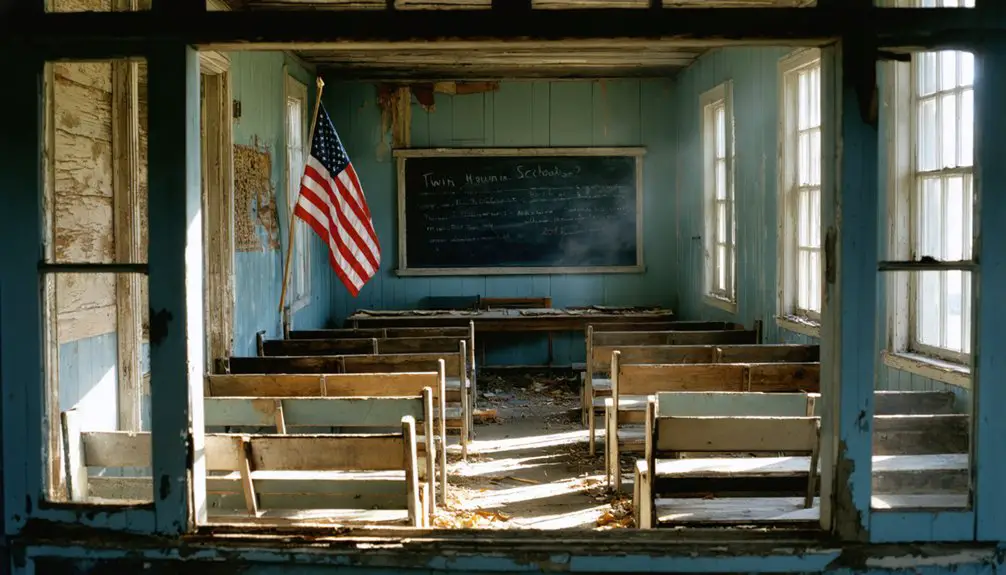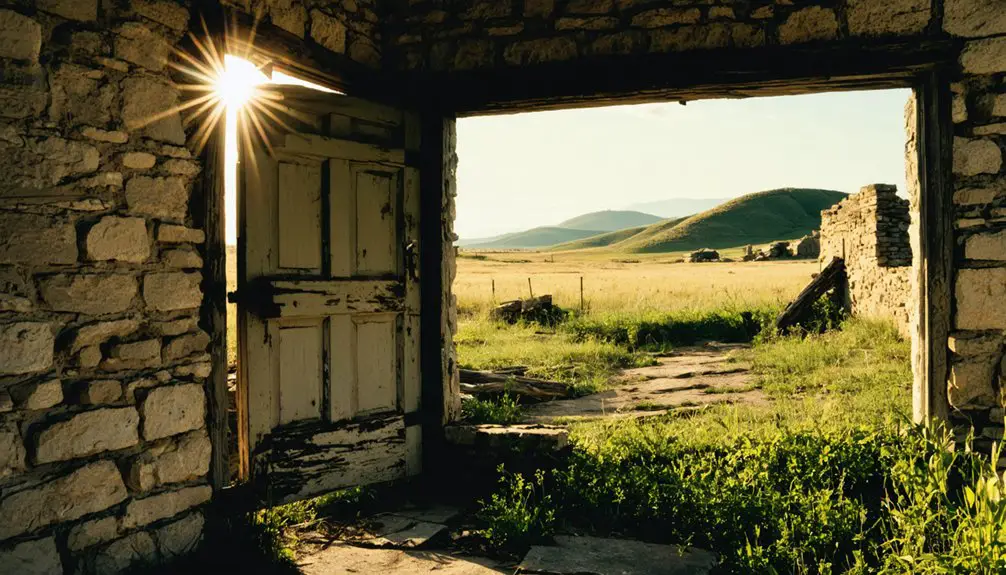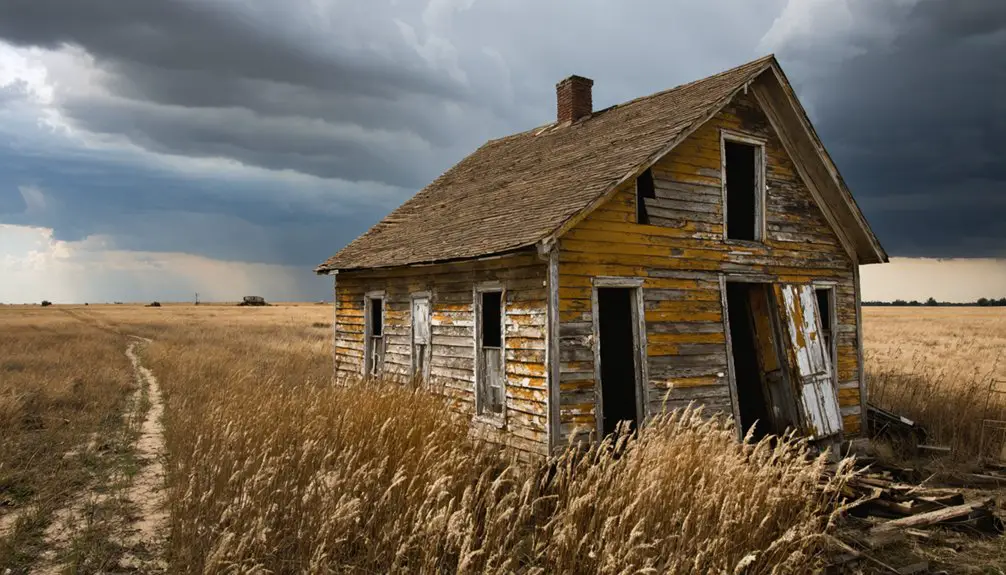You’ll find Twin Mound’s ghost town remnants in western Douglas County, Kansas, where two distinctive natural mounds mark its former location. Founded in 1856 by Quaker abolitionist Henry Hiatt, this prairie settlement thrived around his sawmill and stone grist mill until the early 1900s. The community centered on its one-room schoolhouse, which operated until 1966. While most structures have vanished, the twin mounds still stand as silent witnesses to this once-vibrant settlement’s story.
Key Takeaways
- Twin Mound was established in 1856 by Quaker Henry Hiatt and named after two distinctive natural mounds rising 1,056 feet above Kansas prairie.
- The settlement thrived around Hiatt’s steam sawmill and stone grist mill, with a schoolhouse and cemetery serving as community centers.
- Twin Mound’s decline began with Henry Hiatt’s death in 1900, followed by the closure of its post office in 1903.
- The community’s last significant institution, Twin Mound School, closed in 1966 as Douglas County’s final one-room schoolhouse.
- Economic stagnation and population migration to nearby cities ultimately transformed Twin Mound into an abandoned ghost town.
The Birth of Twin Mound: Henry Hiatt’s Vision
When Henry Hiatt arrived in Kansas Territory in April 1856, he carried more than just his family and belongings – he brought a bold vision for a new community. As a Quaker from Ohio, his abolitionist motivations drew him to this contested land during the tumultuous period of Bleeding Kansas.
You’ll find evidence of his determination in how he transported his pre-built Cincinnati house and established the area’s first steam sawmill. In 1858, he constructed a stone grist mill, adding vital infrastructure to the growing settlement. His efforts were well-documented through historical research that revealed details of Twin Mound‘s early development.
Hiatt’s vision for Twin Mound, named after two distinctive natural mounds in the landscape, embodied his Quaker principles of equality, education, and peaceful prosperity.
Twin Mound rose from the Kansas prairie as a testament to Quaker ideals, where equality and education flourished amid natural landmarks.
Despite the political turmoil, he saw opportunity in this untamed territory. He’d transform 160 acres into a thriving settlement, complete with stage line stops and a close-knit community that reflected his values of freedom and acceptance.
Geographic Features and Natural Landscape
The distinctive twin mounds that caught Henry Hiatt’s eye in 1856 still stand today as silent sentinels over western Douglas County, Kansas.
These natural formations rise gently from the prairie landscape at an elevation of 1,056 feet above sea level, with a third, taller mound visible to their south.
You’ll find these geological anomalies standing out amid the surrounding flatlands, where they’ve served as landmarks for centuries.
The area’s prairie vegetation once dominated the landscape, though Hiatt added walnut trees to the terrain.
Today, you’ll see mostly farmland where the town once thrived, but the mounds remain untouched.
While no major rivers or lakes grace the immediate vicinity, the land’s gentle contours continue to shape local drainage patterns and agricultural practices.
The two distinct mounds have become defining features of the region’s topography.
Life During “Bleeding Kansas”
During the tumultuous “Bleeding Kansas” period of 1854-1861, Twin Mound’s residents found themselves caught in the violent crossfire between proslavery and Free-State factions.
You’d have witnessed constant vigilance as families dealt with raids, reprisals, and the looming threat of guerrilla violence that plagued the Kansas Territory. The Kansas-Nebraska Act had unleashed this bitter conflict by allowing popular sovereignty to determine the slavery question.
Life became increasingly difficult as martial law disrupted daily routines. You couldn’t farm or conduct business freely due to military presence, curfews, and mandatory loyalty oaths. Proslavery advocates from Missouri frequently crossed the border to intimidate and harass local settlers.
The threat of violence from both proslavery forces and abolitionists like John Brown created an atmosphere of fear and suspicion among neighbors. Federal troops patrolled the area, and General Orders forced some residents to relocate, fracturing the community’s bonds.
The political struggle over Kansas’ slavery status transformed Twin Mound into a microcosm of the nation’s deepening divide.
The Town’s Early Development and Economy
You’ll find Twin Mound’s early economic life centered around Henry Hiatt’s sawmill, which processed local timber and provided essential building materials for the growing settlement.
The Hiatt family’s vision for the town included both industrial and agricultural development, with the sawmill operation complementing the fertile farmland that drew settlers to the area. The region’s early settlers were drawn to areas near natural landmarks like the burial mounds that dotted the landscape. Similar to the nearby town of Potosi’s sawmill, this operation helped establish Twin Mound as an early industrial center.
The combination of milling operations and farming created Twin Mound’s initial economic foundation, though the town’s ultimate survival would depend on securing transportation connections beyond the stagecoach route.
Sawmill Powers Local Growth
Shortly after arriving in Bloomington, enterprising settler Henry Hiatt partnered with two associates to establish the area’s first steam sawmill, laying the foundation for Twin Mound’s early growth.
The sawmill’s impact rippled through the community, providing essential lumber for buildings, fences, and barns while attracting new settlers to the region.
You’d have found a bustling economic hub around the mill, with a hotel, blacksmith shop, and druggist setting up nearby operations.
Twin Mound was established by Henry Hiatt in 1857 on a 160-acre homestead located seven miles southwest.
The mill’s presence spurred development of vital community facilities, including a school and cemetery.
Even after Hiatt sold his interest and moved southwest to establish Twin Mound, the sawmill continued powering local commerce until 1880, when a devastating fire destroyed both the mill and adjoining general store, marking the beginning of the town’s decline.
Founding Family’s Economic Vision
When Henry Hiatt arrived in Twin Mound with his disassembled Cincinnati house in tow, he carried more than just building materials – he brought an extensive vision for economic growth.
You’ll find his strategy reflected in the careful selection of land near twin mounds, offering fertile soil and natural landmarks to attract settlers. His steam sawmill, the first in the area, demonstrated his commitment to economic sustainability beyond farming. Early settlers from Pennsylvania and Ohio joined the growing community, drawn by the economic prospects.
Despite territorial conflicts threatening the town’s stability, Hiatt’s vision fostered community resilience through diverse ventures. He established a cemetery, planted various trees for land productivity, and secured a valuable stage line connection to Emporia. The town maintained its rural schoolhouse until 1966, marking the end of an educational era in Douglas County.
While political turmoil and pro-slavery forces challenged Twin Mound’s development, Hiatt’s economic foundation emphasized long-term sustainability through calculated social and commercial investments.
Farming Community Takes Root
As Twin Mound blossomed into a thriving agricultural settlement, the fabric of its early economy wove tightly around crop cultivation and livestock farming.
You’d have found farmers like Henry Hiatt embracing agricultural innovations, planting diverse trees and implementing crop rotation to nurture the challenging Kansas soil.
The general store became your lifeline, where you’d trade butter and animal hides for essential supplies.
You’d gather there not just for commerce, but to share farming wisdom with neighbors.
The Grange Library Association, formed in 1877, offered you valuable agricultural knowledge to combat droughts and grasshopper plagues.
Yet despite these adaptations, Twin Mound’s isolation from the railroad and devastating livestock diseases gradually transformed your bustling community into a quieter, primarily farming settlement.
Twin Mound School: Heart of the Community
Education took root in Twin Mound during 1865 when the local school board purchased two acres of land in Block 13 for $25. From a humble log cabin to a durable stone schoolhouse, Twin Mound School demonstrated remarkable community resilience over its century-long history.
From a $25 plot of land grew a century of learning, as Twin Mound School became the heart of its community.
You’ll find the educational evolution reflected in the 1911 building’s thoughtful design, featuring dual front doors, a cloakroom, and a distinctive belfry.
Inside, students gathered around the teacher’s raised platform, where an organ and desk commanded attention.
Though enrollment fluctuated from 14 students to as few as three, the school remained a crucial community hub until 1966.
When the doors finally closed, over 130 people, including former teachers and 80-year alumni Fred Dezius, gathered to bid farewell to Douglas County’s last one-room schoolhouse.
Social Life and Community Activities

At Twin Mound, you’d find community life centered around local gatherings at farms and homesteads, where neighbors came together to share news, celebrate harvests, and forge lasting bonds.
The town’s two distinctive mounds provided natural backdrops for outdoor social events, while seasonal celebrations brought residents together despite their scattered locations across the rural landscape.
You could often spot informal groups meeting at the schoolhouse for various activities, from religious services to reading circles, until the post office’s closure in 1903 began to diminish these cherished gathering opportunities.
Community Groups and Gatherings
Twin Mound’s community life revolved around three primary social hubs: the church, schoolhouse, and post office. You’d find yourself drawn to religious gatherings, where community bonding flourished through prayer meetings and Sunday schools.
The church, often housed in multi-use buildings or homes, provided essential neighborly support and news-sharing opportunities.
Farm families strengthened their ties through cooperative work bees during planting and harvest seasons. You’d join your neighbors to share equipment and labor, discuss crop yields, and participate in seasonal fairs.
Extended families lived nearby, supporting each other through informal visits, shared meals, and celebrations of births, weddings, and anniversaries.
Local entertainment took shape through storytelling sessions, music, and dances, while the post office (1858-1903) kept you connected to the outside world through regular mail deliveries.
Rural School Social Events
While community gatherings took many forms, the one-room stone schoolhouse built in 1865 became the heartbeat of Twin Mound’s social life for over a century.
You’d find the building bustling with rural gatherings throughout the year – from basket dinners and holiday programs to summer Bible schools run by the Rural Bible Crusade. The school bell’s familiar ring would summon families not just for classes, but for Methodist church activities and Grange Lodge meetings too.
Even as enrollment dwindled from 14 students to just 7 by 1966, the schoolhouse remained essential for community bonding.
When school consolidation finally came, over 130 people gathered for a farewell basket dinner. The Grange’s purchase of the building guaranteed it would continue serving as Twin Mound’s cherished social center.
The Slow Decline of a Kansas Settlement
Following the death of Henry Hiatt in 1900, the once-promising settlement of Twin Mound began its irreversible descent into obscurity. Without its founder’s leadership and vision, the town couldn’t compete with the growing prosperity of Topeka and Lawrence, leading to widespread economic stagnation.
You’d have witnessed a gradual but steady population migration as residents sought better opportunities in nearby urban centers. The post office’s closure in 1903 dealt another blow to the community’s connectivity, while the school’s consolidation into the Wakarusa district in the 1950s further eroded Twin Mound’s independence.
While some descendants of original settlers still work the land their ancestors claimed, the vibrant community that Hiatt envisioned has faded into the Kansas countryside, becoming yet another ghost town in America’s heartland.
Physical Remnants and Historical Sites

Today, scattered across the Kansas prairie, you’ll find the modest physical remnants of Twin Mound’s pioneer past. The original one-room schoolhouse stands as a silent sentinel, while a nearby pioneer cemetery holds the stories of early settlers beneath simple headstones.
Your exploration will reveal the town’s namesake – two natural mounds that have marked this landscape for 175 million years, with a third prominent mound visible to the south. These Jurassic-period formations once guided indigenous travelers and settlers alike.
While most structures have vanished beneath farmland, the cemetery’s significance endures through documented genealogical records. The ghost town’s physical legacy may be sparse, but the schoolhouse, cemetery, and ancient mounds continue to mark this once-thriving settlement’s place in Kansas history.
Legacy and Historical Significance
Through its brief but impactful existence, Twin Mound’s legacy extends far beyond its physical remnants. You’ll find its influence woven into the broader narrative of Kansas settlement, particularly during the tumultuous Bleeding Kansas period.
The town’s Quaker foundations, established by Henry Hiatt, created a cultural continuity that emphasized education, equality, and community spirit – values that still resonate through local families and descendants.
While the town’s physical presence has faded, historical preservation efforts keep its memory alive through the maintained schoolhouse, cemetery, and documented stories.
Though time erased Twin Mound’s buildings, dedicated preservationists ensure its legacy lives on through cherished landmarks and recorded memories.
Twin Mound’s legacy serves as a powerful reflection of frontier determination and abolitionist principles. You can trace its impact through local historical societies, family histories, and the enduring significance of the twin mounds themselves, which remain silent sentinels to this pioneering community’s story.
Frequently Asked Questions
What Happened to Henry Hiatt’s Original Sawmill Building?
You’ll find Hiatt’s sawmill history ended when he dismantled the building in 1857, using its salvaged lumber for building restoration of his new two-story home near Twin Mound, Kansas Territory.
Were Any Notable Figures From Kansas History Buried in Twin Mound Cemetery?
You won’t find any statewide notable figures in Twin Mound Cemetery’s burial records. While historically significant for local pioneers like Henry Hiatt, the cemetery primarily served Twin Mound’s early settlers.
How Many Families Lived in Twin Mound During Its Peak Population?
You’ll find that family demographics peaked at around 10 families during Twin Mound’s heyday, totaling just a few dozen residents before population decline set in during the early 1900s.
Did Twin Mound Have Any Churches or Religious Organizations?
You’d find Twin Mound’s church history centered on one Methodist church, built in 1909, that served until 1929. Before that, religious services happened in the schoolhouse. The church burned in 1970.
What Crops Were Primarily Grown by Twin Mound’s Farming Community?
You’d find Turkey Red wheat dominated your fields, alongside corn for livestock feed. Through careful crop rotation and farming techniques, you’d also grow oats, barley, beans, and maintain vegetable gardens.
References
- https://legendsofkansas.com/twin-mound-kansas/
- https://lostkansas.ccrsdigitalprojects.com/sites/lostkansas/files/private_static/2022-12/LT_DG_TwinMound_Combes.pdf
- https://www.youtube.com/watch?v=8imf9ZEYVSA
- https://www.wakarusamuseum.org/post/i-remember
- https://kids.kiddle.co/Twin_Mound
- https://khri.kansasgis.org/photos_docs/045-0000-00462_19.pdf
- https://www.newspapers.com/article/the-daily-kansas-tribune-henry-hiatt-twi/177731048/
- https://www.wakarusamuseum.org/exhibits
- https://www.wikiwand.com/en/map/Twin Mound
- https://tripomatic.com/en/poi/twin-mounds-poi:1125782



